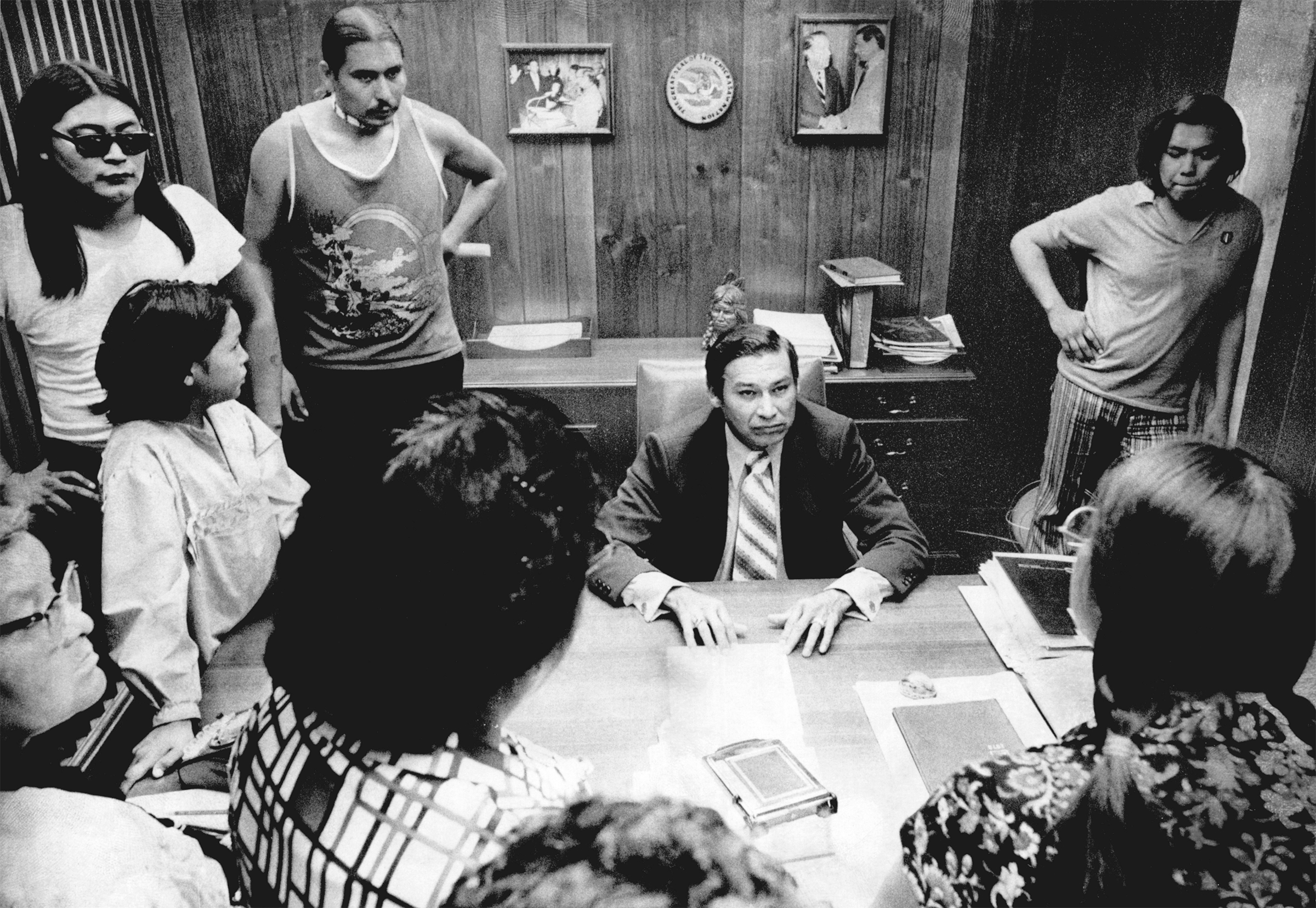
The Encyclopedia of Oklahoma History and Culture
AMERICAN INDIAN MOVEMENT.
Founded in 1968 in Minneapolis, Minnesota, by Clyde and Vernon Bellecourt, Dennis Banks, and George Mitchell, the American Indian Movement (AIM) became the most recognizable Native American activist organization of the late 1960s and 1970s. Its original purpose, to help curb racial profiling of Indians by Minneapolis police officers, soon expanded to that of serving as the mouthpiece as well as the muscle for Native peoples in need across the United States. Described as "the shock troops of American Indian sovereignty and the new warrior class of the century," AIM gained worldwide notoriety for its takeover of the Bureau of Indian Affairs (BIA) building in Washington, D.C., in 1972 and for its standoff with the FBI at Wounded Knee in 1973. Although criticized by whites and Indians alike for its sometimes confrontational tactics, the organization brought the corruption and inefficiency of the BIA to the general public's attention and worked to protect the rights of Indian people caught up in Anglo court and criminal justice systems.
In the 1970s several American Indians from Oklahoma participated in AIM's leadership, taking part in protest activities around the nation. These individuals included Carter Camp (Ponca), David Hill (Choctaw), Stan Holder (Wichita), Paul Chaat Smith (Comanche), and several others. In Oklahoma as many as a dozen AIM chapters have existed.
AIM's first years were quiet; however, the year 1972 marked the height of AIM activity in Oklahoma. In that year, however, several incidents that involved the group made headlines across the nation. The first occurred on September 12 when a group of forty to fifty Indians took over the Oklahoma City office of Overton James, state Indian education director (James was also governor of the Chickasaw Nation). They demanded that he resign his position, and they even typed a letter of resignation for him. They accused his department of not exercising sufficient control over the ways in which Oklahoma schools spent federal Indian education monies. Each year, approximately 150 Oklahoma school districts having a 10 percent or greater American Indian enrollment received roughly $2 million in funds allocated by the 1934 Johnson-O'Malley Act (JOM). JOM funds, intended to defray the costs of bilingual teacher's aids, instructor workshops, and transportation costs of students, was, according to protesters, being spent on the general student body (non-Indian as well as Indian), to the detriment of Native pupils. Carter Camp, AIM coordinator for Kansas and Oklahoma and one of the leaders of the office takeover, telephoned the BIA headquarters in Washington, D.C., during the occupation to request that all JOM monies be frozen until an investigation of alleged improprieties could be undertaken. In response, the bureau agreed to send three representatives to meet with Camp and others the next day at the BIA office in Pawnee, in Pawnee County.
Afternoon talks on September 13 reached an impasse. Because the BIA building was closing for the day, AIM leaders John Trudell (Sioux), Camp, and mainly Oklahoma Indians occupied the facility until a deal with BIA officials could be negotiated. Eventually, the two sides negotiated a compromise, with the Indians declaring a "clear-cut victory." Commissioner of Indian Affairs Louis Bruce ordered an immediate freeze on spending of JOM funds for the 1972–73 fiscal year until an outside audit of expenditures could be conducted. He also agreed to allow more Native input on how future Indian education monies for the state were spent.
The white citizens of Pawnee viewed the takeover and subsequent agreement as another example of the federal government acquiescing to the demands of a handful of militant Indians. An editorial in the local paper probably reflected the feelings of most non-Indians in that community: "A few bureaucrats in the Indian office at Washington who have the backbone of a jelly fish and the guts of an angle worm gave in to trouble makers. They should be fired." Regardless of how the local populace felt about the incident, the occupation exposed and publicized the misappropriation of JOM funds in the state and offered hope that such monies would be used to help those for whom they were intended in the future: the Indian students of Oklahoma.
Less than a month after the events at Oklahoma City and Pawnee, AIM answered a call for assistance from students at the Fort Sill Indian School (FSIS) near Lawton. Upset at the perceived unresponsiveness of the school's white superintendent, principal, and teachers to student grievances and also opposing its early curfew that required students be in the dorms by sundown and objecting to the institution of a ROTC program on campus that fall, a group of between forty and fifty pupils and eight to ten AIM members broke into the Administration Building at FSIS on the evening of October 2, 1972. They remained there for nearly twenty-four hours. When the affair ended, Lawton police had arrested and subsequently released four individuals for trespassing: Debbie Chapman, a student at the school, and AIM members Ozzie Red Elk, Stan Holder, and Frances Wise. In addition, BIA officials ordered administrative leave for FSIS Superintendent Jack Williams and Principal Bob Randolph until complaints against them could be investigated. Although the Administration Building takeover may have had few long-term consequences, it demonstrated that AIM was not simply an organization devoted to its own interests. It has responded to the needs of Indians wherever and whenever they might occur.






